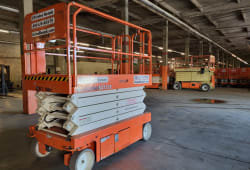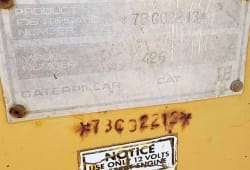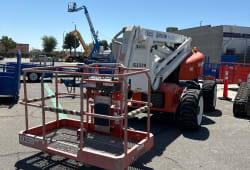Regulations Governing Aggregate Mining
10 Lectura mínima
)
septiembre 4, 2023
Aggregate mining involves the extraction of sand, gravel, and crushed stone from natural deposits. These materials play a crucial role in construction projects, such as building roads, bridges, and buildings. However, the process of using mineral resources for aggregate mining can have significant environmental impacts if domestic mineral resource extraction is not properly regulated.
The Environmental Protection Agency (EPA) regulates mining claims on federal land through the Mineral Leasing Act and the National Environmental Policy Act (NEPA). The EPA ensures that mining claims do not damage valuable mineral deposits or harm the environment and that mining claims are consistent with federal land policy.
The Different Types of Aggregate Mining Regulations
Aggregate mining is the extraction of sand, gravel, and other aggregates from the Earth's crust, which may also contain certain valuable mineral deposits. Regulations governing aggregate mining can vary depending on the region and the authorities involved. Different regulations address various aspects of domestic mining, such as environmental protection, safety standards, and operational guidelines.
Who Regulates Aggregate Mining?
Aggregate mining is subject to regulation at the federal government, federal and state laws, and state and local government levels. Federal agencies, state departments, and local authorities all play a role in overseeing and enforcing the rules related to aggregate mining.
The Purpose of Aggregate Mining Regulations
The primary purpose of aggregate mining regulations is to develop mineral resources and to strike a balance between meeting the demand for construction materials and safeguarding the environment. These regulations aim to ensure responsible and sustainable mining practices.
The Impact of Aggregate Mining Regulations on the Industry
Aggregate mining regulations have a significant impact on the industry. While they impose certain limitations and requirements on foreign mining operators, they also encourage innovation and the adoption of eco-friendly practices in mining operations.
The Future of Aggregate Mining Regulations
The future of aggregate mining regulations is likely to be shaped by advancements in mining industry investment in technology and growing environmental concerns. Stricter regulations and increased focus on sustainability are expected to drive changes in the industry.
The Top 5 Aggregate Mining Regulations You Need to Know
Regulations governing aggregate mining are essential to ensure responsible and sustainable practices within the industry. As a mining operator or someone interested in the field, understanding the top five regulations is crucial to staying compliant and contributing to environmental protection. Here's a detailed explanation of each regulation:
1. Environmental Impact Assessments (EIAs)
Before initiating any mining project, companies are required to conduct Environmental Impact Assessments (EIAs). These assessments involve a comprehensive evaluation of the potential environmental impacts of the proposed mining activities. By identifying potential risks and impacts, companies can develop effective mitigation measures to minimize harm to the surrounding ecosystem. EIAs also help stakeholders, including regulatory bodies and local communities, understand the implications of the mining project.
2. Water Management
Water plays a vital role in aggregate mining operations, but it can also be a significant source of environmental pollution. To address this, mining companies must implement proper water management strategies. These strategies include measures to prevent water contamination from mining activities, effective sediment control, and proper management of runoff. Sustainable water management not only protects local water resources but also ensures that nearby communities have access to clean water.
3. Rehabilitation Plans
Responsible mining goes beyond the extraction phase. It includes planning for the post-mining phase to restore the site to its natural state or find alternative uses. As part of the mining permit application, companies must submit detailed rehabilitation plans. These plans outline how the site will be rehabilitated, including re-vegetation, landscaping, and soil restoration. Proper rehabilitation ensures that former mining sites can be integrated back into the environment, minimizing long-term environmental impacts.
4. Dust and Noise Control
Mining operations can generate significant amounts of dust and noise, which can impact nearby communities and ecosystems. To mitigate these effects, mining companies are required to implement dust and noise control measures. Dust suppression techniques, such as using water sprays, can help reduce airborne particles, while noise barriers and operational adjustments can minimize noise levels. Effective control measures promote better relations with local communities and protect the health of both humans and wildlife.
5. Compliance Monitoring
Regular monitoring and reporting are essential to ensure that mining companies adhere to all relevant regulations and guidelines. Compliance monitoring involves routine inspections by regulatory authorities to assess a company's adherence to environmental and safety standards. Mining companies must maintain detailed records and reports related to their operations and environmental impacts. The data collected during compliance monitoring helps identify any non-compliance issues and facilitates corrective actions.
How to Stay Compliant with Aggregate Mining Regulations
Staying compliant with aggregate mining regulations and federal laws is crucial for the success of mining operations and the protection of the environment. Here are essential steps that mining companies can take to ensure compliance with mining and federal law, and promote responsible mining practices:
Educate Staff
The first step in maintaining compliance is to educate all employees about the relevant regulations and best practices. Mining companies should provide comprehensive training to their staff to ensure that everyone understands their responsibilities and the potential impacts of non-compliance. Well-informed employees are more likely to follow regulations diligently and contribute to a culture of compliance within the organization.
Regular Audits
Conducting internal audits is a proactive way to identify any areas of non-compliance and address them promptly. Regular audits help mining companies assess their operations, procedures, and documentation to ensure that they align with regulatory requirements. These audits can be performed by internal teams or external experts to gain an objective perspective on the company's compliance status.
Engage with Regulators
Building and maintaining a positive relationship with regulatory authorities is essential. Mining companies should keep an open line of communication with relevant agencies and authorities. This proactive approach allows companies to stay informed about any changes in regulations, new requirements, or upcoming inspections. Engaging with regulators also demonstrates a commitment to responsible mining practices.
Invest in Technology
Embracing technology can significantly enhance compliance efforts. Mining companies can invest in advanced environmental monitoring systems, data analytics tools, and safety equipment. These technologies enable better tracking of environmental impacts, early detection of potential issues, and the ability to implement preventive measures. Advanced technology not only improves compliance but also supports efficient and sustainable mining practices.
Collaborate with Stakeholders
Engaging with local communities, environmental groups, and other stakeholders is vital for successful compliance. By involving stakeholders in the decision-making process and seeking their input, mining companies can address concerns and build trust. This collaborative approach helps reduce opposition to mining projects and fosters a sense of shared responsibility for environmental protection.
Document and Report
Accurate and comprehensive record-keeping is essential for demonstrating compliance. Mining companies should maintain detailed documentation of their operations, environmental monitoring data, and any corrective actions taken. Regular reporting to regulatory agencies is also necessary to provide transparent information about the company's environmental and safety performance.
Implement Continuous Improvement
Compliance with aggregate mining regulations is an ongoing process. Mining companies should continuously review and improve their operations, procedures, and mitigation measures. Adopting a mindset of continuous improvement allows companies to stay ahead of changing regulations federal tax laws, and evolving industry best practices.
The Challenges of Enforcing Aggregate Mining Regulations
Enforcing aggregate mining law reform regulations presents various challenges for regulatory authorities and stakeholders involved in the oversight of the mining industry. These challenges stem from the complexities of the mining process, the vast scale of mining operations, and the need to strike a balance between economic development and environmental conservation. Here are some of the key challenges faced in enforcing aggregate and mining laws and regulations:
Limited Resources
Regulatory agencies often have limited resources in terms of funding, manpower, and technology. Inspecting and monitoring numerous mining sites spread across large areas can be overwhelming. The lack of adequate resources can hinder the ability to conduct regular inspections and enforce regulations effectively.
Evolving Technology
The mining industry is continually evolving, with new technologies and mining methods being introduced. Keeping up with these advancements and understanding their potential impacts on the environment requires ongoing training and expertise. Regulatory authorities must stay updated to ensure that regulations remain relevant and effective.
Illegal Mining
Illegal mining activities pose a significant challenge to enforcement efforts. Some operators may engage in unpermitted mining, bypassing regulatory controls and environmental safeguards. Illegal mining not only leads to environmental degradation but also undermines the efforts of law-abiding mining companies.
Lack of Data
Accurate data on the environmental impacts of aggregate mining is crucial for effective regulation. However, obtaining comprehensive data on all aspects of mining, such as water usage, air quality, and habitat disturbance, can be challenging. Without sufficient data, it becomes difficult to assess compliance and enforce specific regulations.
Enforcement Coordination
Multiple regulatory bodies may be involved in overseeing different aspects of aggregate mining, including environmental agencies, mining departments, and local authorities. Ensuring effective coordination among these entities can be complex and may lead to gaps or overlaps in enforcement efforts.
Public Pressure and Perception
Balancing the demands of economic development and environmental protection can be a delicate task. Public pressure and perception often influence regulatory decisions. Striking the right balance between fostering economic growth and safeguarding the environment can lead to conflicting interests and challenges in enforcement.
Political Interference
In some cases, political pressure or interference may affect the enforcement of mining regulations. Political considerations may influence regulatory decisions, potentially compromising the objective application of the rules.
Litigation and Appeals
Legal challenges and appeals from mining operators can further complicate the enforcement process. Lengthy legal proceedings can delay enforcement actions, creating uncertainties for both regulatory authorities and the mining industry.
Conclusion
Regulations governing aggregate mining play a critical role in ensuring the sustainable use of land management of natural resources while protecting the environment. By understanding and complying with these regulations, the industry can thrive while minimizing its ecological footprint. As consumers, we have the power to drive positive change by supporting responsible mining practices and demanding accountability from mining companies.

Caleb Woods is an experienced content specialist and an editor at Boom & Bucket, blending his journalism background with expertise in the heavy equipment industry. He delivers engaging, informative content to help professionals stay informed and make smarter decisions in the machinery market.











